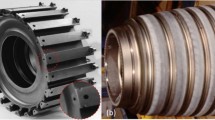Abstract
Wire electrical discharge machining (WEDM) is a manufacturing process whereby a desired shape is obtained using electrical discharges (sparks). WEDM demands high cutting rate and high quality to improve machining performance for manufacturing hard materials. The machining performance of computer-controlled WEDM is directly dependent on spark energy and pulse frequency parameters including discharge voltage, peak current, pulse duration, and charging time. In this paper, a new performance index to measure the effects of spark energy and pulse frequency on machining performance is proposed. Moreover, the effects of electric process parameters on performance measures including cutting speed, surface roughness, and white layer thickness are introduced.
Similar content being viewed by others
References
Davim JP (2008) Machining fundamentals and recent advances. Springer, London
Muttamara A, Fukuzawa Y, Mohri N, Tani T (2003) Probability of precision micro-machining of insulating Si3N4 ceramics by EDM. J Mater Process Technol 140:243–247
Wüthrich R, Fascio V (2005) Machining of non-conducting materials using electrochemical discharge phenomenon—an overview. Int J Mach Tools Manuf 45:1095–1108
Maher I, Sarhan AAD, Hamdi M (2015) Review of improvements in wire electrode properties for longer working time and utilization in wire EDM machining. Int J Adv Manuf Technol 76:329–351
Cheng X, Yang XH, Huang YM, Zheng GM, Li L (2014) Helical surface creation by wire electrical discharge machining for micro tools. Robot Comput Integr Manuf 30:287–294
Maher I, Ling LH, Sarhan AAD, Hamdi M (2015) Improve wire EDM performance at different machining parameters—ANFIS modeling, 8th Vienna International Conference on Mathematical Modelling (MATHMOOD 2015), IFAC, Vienna University of technology, Vienna, Austria, pp. 105–110
Yeh C-C, Wu K-L, Lee J-W, Yan B-H (2013) Study on surface characteristics using phosphorous dielectric on wire electrical discharge machining of polycrystalline silicon. Int J Adv Manuf Technol 69:71–80
Maher I, Sarhan AAD, Marashi H (2016) Effect of electrical discharge energy on white layer thickness of WEDM process, Reference Module in Materials Science and Materials Engineering, Elsevier
Yan M-T, Liu Y-T (2009) Design, analysis and experimental study of a high-frequency power supply for finish cut of wire-EDM. Int J Mach Tools Manuf 49:793–796
Gökler Mİ, Ozanözgü AM (2000) Experimental investigation of effects of cutting parameters on surface roughness in the WEDM process. Int J Mach Tools Manuf 40:1831–1848
El-Hofy H (2005) Advanced machining processes. McGraw-Hill, New York
Levy GN, Maggi F (1990) WED machinability comparison of different steel grades. CIRP Ann Manuf Technol 39:183–185
Patil N, Brahmankar PK (2010) Determination of material removal rate in wire electro-discharge machining of metal matrix composites using dimensional analysis. Int J Adv Manuf Technol 51:599–610
Liao YS, Yu YP (2004) Study of specific discharge energy in WEDM and its application. Int J Mach Tools Manuf 44:1373–1380
Singh A, Ghosh A (1999) A thermo-electric model of material removal during electric discharge machining. Int J Mach Tools Manuf 39:669–682
Cabanes I, Portillo E, Marcos M, Sánchez JA (2008) On-line prevention of wire breakage in wire electro-discharge machining. Robot Comput Integr Manuf 24:287–298
Salah NB, Ghanem F, Atig KB (2006) Numerical study of thermal aspects of electric discharge machining process. Int J Mach Tools Manuf 46:908–911
Izquierdo B, Sánchez JA, Plaza S, Pombo I, Ortega N (2009) A numerical model of the EDM process considering the effect of multiple discharges. Int J Mach Tools Manuf 49:220–229
Dekeyser W, Snoeys R, Jennes M (1988) Expert system for wire cutting EDM, based on pulse classification and thermal modeling. Robot Comput Integr Manuf 4:219–224
Lee C-S, Heo E-Y, Kim J-M, Choi I-H, Kim D-W Electrode wear estimation model for EDM drilling, Robotics and Computer-Integrated Manufacturing
Gostimirovic M, Kovac P, Sekulic M, Skoric B (2012) Influence of discharge energy on machining characteristics in EDM. J Mech Sci Technol 26:173–179
Salonitis K, Stournaras A, Stavropoulos P, Chryssolouris G (2009) Thermal modeling of the material removal rate and surface roughness for die-sinking EDM. Int J Adv Manuf Technol 40:316–323
Jahan M (2013) Micro-electrical discharge machining. In: Davim JP (ed) Nontraditional machining processes. Springer, London
Ferreira J (2007) A study of die helical thread cavity surface finish made by Cu-W electrodes with planetary EDM. Int J Adv Manuf Technol 34:1120–1132
Portt J (1992) Introduction to wire EDM. John Portt, Michigan
Jameson EC (2001) Electrical discharge machining. Society of Manufacturing Engineers, Dearborn, Michigan
McGeough, J A (1988) Electrodischarge machining. In: Advanced methods of machining. Shapman and Hall, London, New York
Ramasawmy H, Blunt L, Rajurkar KP (2005) Investigation of the relationship between the white layer thickness and 3D surface texture parameters in the die sinking EDM process. Precis Eng 29:479–490
Jangra K, Grover S, Aggarwal A (2011) Simultaneous optimization of material removal rate and surface roughness for WEDM of WC-Co composite using grey relational analysis along with Taguchi method. Int J Ind Eng Comput 2:479–490
Zipperian DC (2011) Metallographic handbook. PACE Technologies, Arizona
Montgomery DC, Runger GC (2003) Applied statistics and probability for engineers, 3 ed., Wiley.
Author information
Authors and Affiliations
Corresponding authors
Rights and permissions
About this article
Cite this article
Maher, I., Sarhan, A.A.D. Proposing a new performance index to identify the effect of spark energy and pulse frequency simultaneously to achieve high machining performance in WEDM. Int J Adv Manuf Technol 91, 433–443 (2017). https://doi.org/10.1007/s00170-016-9680-3
Received:
Accepted:
Published:
Issue Date:
DOI: https://doi.org/10.1007/s00170-016-9680-3




